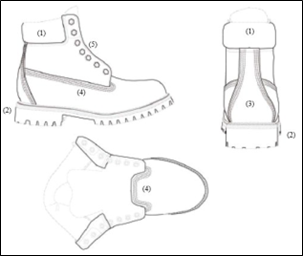The US Court of Appeals for the Fourth Circuit affirmed a district court’s summary judgment grant in a trademark dispute, finding that the district court did not err in concluding that a subset of design elements lacked distinctiveness in the public’s view. TBL Licensing, LLC v. Katherine Vidal, Director of the United States Patent and Trademark Office, Case No. 23-1150 (4th Cir. Apr. 15, 2024) (Quattlebaum, Gregory, Benjamin, JJ.)
TBL Licensing is commonly known as Timberland, the prominent footwear manufacturer. Timberland tried to register specific design elements of its popular boot as protected trade dress with the US Patent & Trademark Office (PTO). In its application, Timberland provided a detailed written description of the boot design elements it sought to register as protectable trade dress. Timberland also included a drawing of these design elements.

The PTO rejected Timberland’s application, finding that the design was functional and lacked distinctiveness. Timberland appealed to the Trademark Trial & Appeal Board, which affirmed. Timberland then challenged the Board’s decision in the US District Court for the Eastern District of Virginia. The district court granted summary judgment in favor of the PTO because Timberland’s design was functional and had not acquired distinctiveness. Timberland appealed.
Timberland argued that the district court improperly segmented the design during its functionality analysis. Timberland argued that the district court failed to meaningfully consider the design as a whole, and even if it did, the court erred in considering specific factors, including the availability of alternative designs and the design’s simplicity in manufacturing. The court also relied on inapposite patents and advertisements as evidence to support its functionality finding, an analysis that Timberland argued was improper.
The Fourth Circuit affirmed the district court’s decision. While acknowledging the potential error in the district court’s failure to analyze the design holistically, the Court ultimately found that the limited design elements Timberland sought to register lacked secondary meaning – a crucial element for trade dress protection. The Court employed a secondary meaning analysis to assess public perception of Timberland’s design and considered various factors, including advertising expenditures, consumer studies, sales success, unsolicited media coverage, attempts at imitation and length of exclusive use.
Applying each factor, the Fourth Circuit determined that the district court did not clearly err in finding that the design elements lacked distinctiveness. The Court explained that the district court highlighted flaws in Timberland’s consumer survey, noting suggestive questions and a lack of focus on the claimed design features. The district court also emphasized that Timberland’s advertising expenditures did not effectively link the claimed design features with Timberland in consumers’ minds. Timberland’s arguments regarding sales success, media coverage and attempts at plagiarism were also found insufficient to establish secondary meaning. Lastly, the presence of similar-looking boots from other manufacturers undermined Timberland’s claim of exclusivity in using the design.
Lacking direct consumer survey evidence, the Fourth Circuit determined that Timberland’s circumstantial evidence failed to establish consumer recognition of the specific design elements Timberland sought to register. The Court also agreed that the prevalence of similar products in the marketplace undermined the design’s uniqueness as an indicator of brand association with Timberland.
Practice Note: When seeking trade dress protection for product designs, demonstrating both nonfunctionality and distinctiveness is imperative. This case serves as a reminder to thoroughly analyze and present direct evidence to establish the uniqueness and nonfunctional aspects of a design when pursing trade dress registration.
[View source.]